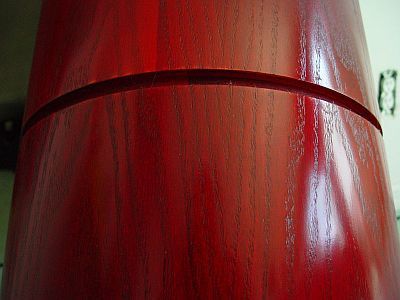Question
I have been fighting a problem for a while now. I started with a cotton blend stain rags and moved up to 100% cotton. I still have problems with the rags catching in the grain. I blow everything off before sealing with Max thinned 10%, but the sealer coat is always rough. I prep sand at 150. Everything sands out ok but I've really got picky on my work and this is driving me crazy. Does anyone have any suggestions?
Forum Responses
(Finishing Forum)
From contributor D:
You are writing about two unrelated problems. (1) Your rags get caught on the grain. (2) Your first coat which you call your sealer coat is rough and not smooth.
The problem is not your rags. although most finishers prefer all cotton wipes, certainly lint-free wipes. Stain can be applied by brush, spray, rag or sponge. But removal of stain excess is best done by rag.
If you are staining bare wood that has no washcoat (a coating with less than 6% solids by volume) or no sealer coat (a coating with less than 12% solids by volume) then there are wood fibers that can catch on your rag. But if you washcoat first, then scuff, then stain, then your stain does not bite in with the full color strength. You have to decide which way to go because finishing is always about making choices, no one choice a one-size-fits-all.
Washcoating/sealing locks the errant fibers so that you can cut them when you sand your washcoat/sealercoat. Using vinyl sealer as your first coat gives you a smoother wipe than if you use your topcoat as your first coat. Vinyl sealer is also smoother than the conventional stearated sealers that are used to establish a base coating on top of which nitrocellulose lacquers are built.
First coats are usually rough. That's why they are scuffed well with 220 grit or 280 grit or 320 grit, depending on the solids content (by volume) of your next topcoat. Scuffing with 220 grit will often give you sand-swell scratch marks (leave a visible scratch pattern) in your subsequent topcoat. The tech sheet of your topcoat will tell you which is best to scuff with so that you do not have the scratch pattern telegraphing though.
Sanding with too fine a grit will leave you no scratch pattern big enough for the next coat of finish to adhere to. Most coating that we wood finishers use are self-sealing. To call a coating self-sealing is not only useless, but it does more to spread confusion about what sealers do and why a coating could be considered self-sealing. The important thing that is ignored or given little attention are those specific coatings which require a different sealer.
A coating which calls itself self-sealing does not mean that you are better off without a separate sealer coat (like vinyl sealer or dewaxed shellac or both). The demands of your finish schedule (determined by you and not the marketers) ought to tell you which to use as a sealer. As long as you are within the confines of what your tech sheets tell you and you are not pushing the envelopes of your materials and are not playing maverick, then you decide what to use as a sealer. "Self-sealing" does not mean that this is the best for you.
It means only one thing, that with regard to coatings that are not at their best as "self-sealers", your self-sealing coating is not one of those. And that's all it means. None of the grandiose hype is useful to us as finishers. Too much is misunderstood about what sealers are and what they are not, what they do best and how to choose one type from another based on our needs at the moment.
Where does the "self-sealing" hype come from? If a finisher does not need so many specialty coatings in the lockers and around the shop, then there is less to buy, less to clean out, less to do, less to take up valuable room (there is never enough room; never enough light; never enough time). Again, it is the quest for one-size-fits-all that is the big push behind this hype.
If you can get away with this hype, great. Thanks to the silliness, what happens when you sand through a layer of precat or post cat? You need to spot spray with vinyl sealer. Now, you need to run out and buy a container of a product that you thought that you could do without. Work out as simple a finish schedule that you can get away with. Any more than that and you will start to hate the art of it and detest the whole process.
Without asking you to go into a full explanation, is there a source that you would recommend for a clear explanation and understanding? I'm not looking a brief answer, rather a good foundational comprehension so that I make accurate decisions concerning the need for sealers.
